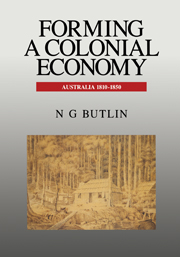Book contents
- Frontmatter
- Contents
- List of Tables
- List of Figures
- Acknowledgements
- Part I Forming an Economy
- Part II The Colonial Peopling of Australia: 1788–1850
- 1 Introduction
- 2 Gross Additions to the Australian Population
- 3 The Colonial Population Stock
- 4 Human Capital in Convicts
- Part III Public Funding of Colonial Development: 1788–1850
- Part IV The Colonial Australian Economy 1810–1840—A Historical, Statistical and Analytical Account
- Bibliography
- Appendixes
- Index
3 - The Colonial Population Stock
from Part II - The Colonial Peopling of Australia: 1788–1850
Published online by Cambridge University Press: 04 August 2010
- Frontmatter
- Contents
- List of Tables
- List of Figures
- Acknowledgements
- Part I Forming an Economy
- Part II The Colonial Peopling of Australia: 1788–1850
- 1 Introduction
- 2 Gross Additions to the Australian Population
- 3 The Colonial Population Stock
- 4 Human Capital in Convicts
- Part III Public Funding of Colonial Development: 1788–1850
- Part IV The Colonial Australian Economy 1810–1840—A Historical, Statistical and Analytical Account
- Bibliography
- Appendixes
- Index
Summary
Projecting Population and Workforce Components
Because of its relative novelty, this section requires a good deal of statistical documentation to substantiate a possible picture of the stock of population and workforce derived by population projection techniques. A verbal summary of the main implications is given at the end of the section.
The three major sources of increase, convicts, free immigrants and colonial born, are subject to losses from death and out-migration. One might expect that different factors could determine the growth of each element. So far as inflows were concerned, the first group was located in Australia coercively, the second responded primarily to socioeconomic push conditions and the third had, at best, a tenuous connection with economic incentives. Death rates were influenced strongly by environmental conditions in Australia affecting age-specific life expectations (in a highly favourable manner). And out-migration was subject, above all, to opportunities for absconding by convicts and the financial and legal restraints on the return to Britain of time-expired convicts.
There are several obstacles to defining the contributions of the three major sources of population or workforce. Firstly, the accuracy of the official aggregates at Musters and Censuses is not high. Secondly, even when some of the components are reported in official estimates, there are many obvious errors in the available figures. Thirdly, only very incomplete records are available of the major components.
- Type
- Chapter
- Information
- Forming a Colonial EconomyAustralia 1810–1850, pp. 32 - 45Publisher: Cambridge University PressPrint publication year: 1994



